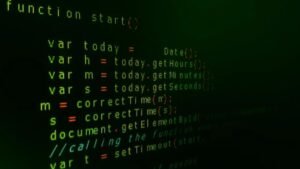Neural Network: Supervised or Unsupervised
In the field of artificial intelligence, neural networks play a crucial role in solving complex problems by mimicking the human brain’s ability to learn and adapt. They are a type of machine learning algorithm that can be trained to recognize patterns and make intelligent decisions. Neural networks can be categorized into two main types: supervised and unsupervised learning.
Key Takeaways:
- Neural networks are vital in artificial intelligence as they mimic the human brain.
- There are two main types of neural networks: supervised and unsupervised learning.
- Supervised learning uses labeled data to train the network, while unsupervised learning works with unlabeled data.
- Supervised learning is ideal for classification and regression problems, while unsupervised learning is beneficial for pattern recognition and clustering tasks.
Supervised Learning:
Supervised learning is a type of neural network training where the algorithm learns from labeled data. In this approach, the input data and their corresponding correct output (label) are provided to the network. Through multiple iterations, the algorithm adjusts the weights of the connections between the neurons to minimize the error between the predicted output and the actual output. This process enables the neural network to generalize from the given inputs and correctly classify or predict new, unseen data. *Supervised learning is widely used in applications such as spam detection and image recognition.*
Unsupervised Learning:
Unsupervised learning, on the other hand, involves training neural networks with unlabeled data, meaning there are no pre-defined correct answers. The network needs to find patterns and relationships in the data without explicit guidance. *The autonomy of unsupervised learning leads to the discovery of hidden or unknown patterns, making it an interesting approach.* It is particularly useful in tasks such as clustering similar data points and detecting anomalies in large datasets.
Differences and Use Cases:
| Supervised Learning | Unsupervised Learning |
|---|---|
| Uses labeled data as training input | Uses unlabeled data as training input |
| Ideal for classification and regression problems | Beneficial for pattern recognition and clustering tasks |
| Requires labeled data for training | Can work with raw, unlabeled data |
Benefits of Neural Networks:
- Ability to learn complex patterns and make intelligent decisions.
- Adaptability to handle changes and noise in input data.
- Capability to process large amounts of data efficiently.
- Potential to automate tasks and improve decision-making processes.
Challenges and Limitations:
- Requires extensive computational resources.
- May suffer from overfitting if the training dataset is too small or biased.
- Interpretability of neural networks can be challenging, making them less transparent than traditional machine learning algorithms.
- Training time can be significant, especially for deep neural networks.
Conclusion:
Neural networks are powerful tools in the field of artificial intelligence, with supervised and unsupervised learning as two fundamental approaches. While supervised learning works well for well-labeled datasets and specific tasks, unsupervised learning offers the advantage of autonomous discovery and adaptation to unlabeled data. Both types provide distinct benefits and are essential in solving complex problems and making intelligent decisions.

Common Misconceptions
Supervised Learning is Always Better
One common misconception about neural networks is that supervised learning is always superior to unsupervised learning. While supervised learning relies on labeled data to learn a specific task, unsupervised learning has its own merits. Some points to consider are:
- Unsupervised learning can discover hidden patterns or structures in data.
- Unsupervised learning helps in data preprocessing and feature extraction.
- Unsupervised learning can be useful when labeled data is scarce or expensive to obtain.
Unsupervised Learning Can Replace Supervised Learning
Another misconception is that unsupervised learning can completely replace supervised learning. However, both approaches serve different purposes and have their own advantages. Here are a few key points:
- Supervised learning is more suitable for tasks that require specific predictions or classifications.
- Unsupervised learning is useful for exploratory data analysis and finding patterns in large datasets.
- Supervised learning provides more well-defined evaluation metrics and can be easily interpreted.
Neural Networks Can Solve Any Problem
Neural networks are powerful tools, but they are not a universal solution for all problems. It is important to understand their limitations and consider alternative approaches when necessary. Some important things to note are:
- Neural networks require substantial amounts of labeled training data to perform well.
- They can be computationally expensive and may require significant computational resources.
- For some problems, simpler algorithms can provide equally good or even better results.
Unsupervised Learning Doesn’t Need Labels
Contrary to popular belief, unsupervised learning can make use of labeled data, even though it is not a strict requirement. Here are a few scenarios where labeled data can be beneficial in unsupervised learning:
- Using labeled data for evaluation to measure the performance of the unsupervised learning model.
- Using labeled data as a reference to identify and validate discovered patterns or clusters.
- Using labeled data to provide initial guidance or hints for the unsupervised learning process.
More Layers Always Mean Better Performance
An often misunderstood concept is that increasing the number of layers in a neural network will automatically lead to better performance. However, this is not always the case. Consider these points:
- Adding more layers can increase the risk of overfitting the data.
- Increasing the number of layers increases computational complexity and training time.
- A well-designed network with fewer layers might perform better than a deeper but poorly designed network.

Introduction
Neural networks, a subset of artificial intelligence, have shown remarkable potential in solving complex problems across various domains. One crucial aspect of neural networks is their learning process, which can either be supervised or unsupervised. In supervised learning, the network learns from a labeled dataset, while in unsupervised learning, it identifies patterns on its own. In this article, we explore the differences between these approaches and their applications. Below are ten informative tables that illustrate various aspects of the neural network’s supervised and unsupervised learning methods.
Table 1: Supervised Learning Applications
Supervised learning is widely used in various domains, including image recognition, speech analysis, and machine translation. By providing labeled data for training, neural networks, under supervised learning, can accurately classify or predict outputs. For instance, in image recognition, the network can identify objects or emotions captured by a camera, enabling powerful applications such as biometric identification or sentiment analysis.
Table 2: Unsupervised Learning Applications
Unsupervised learning is advantageous when the available data lacks labels or the underlying patterns are unknown. Through the use of clustering and dimensionality reduction techniques, neural networks can uncover hidden structures within the data. This approach finds applications in anomaly detection, recommendation systems, and market segmentation, where identifying hidden patterns or outliers is crucial.
Table 3: Supervised Learning Process
Supervised learning requires a well-defined training dataset with labeled examples. The neural network learns from this dataset to map input features to desired outputs. By optimizing the network parameters, the model aims to minimize the difference between the predicted and actual outputs. The learning process involves forward propagation, backpropagation, and gradient descent algorithms.
Table 4: Unsupervised Learning Process
Unlike supervised learning, unsupervised learning does not rely on labeled data. Instead, the network learns from the inherent structure of the input data. The process can involve clustering, where similar data points are grouped together, or dimensionality reduction, reducing the complexity of the input. Through iterations and optimization, the neural network gains a deeper understanding without explicit guidance.
Table 5: Supervised Learning Advantages
Supervised learning offers several advantages, including precise predictions, structured decision-making, and a clearer inference of causality. By leveraging labeled data, neural networks can learn to associate features with specific outputs, enabling accurate predictions and well-defined decision boundaries. Furthermore, the ability to understand causal relationships can be crucial in domains like healthcare and finance.
Table 6: Unsupervised Learning Advantages
Unsupervised learning has its own set of advantages, such as pattern discovery, feature extraction, and exploration of hidden relationships. By analyzing unlabeled data, neural networks can uncover underlying structures, which can lead to new insights and discoveries. Additionally, unsupervised learning aids in feature extraction, enabling the system to automatically identify relevant features from raw data.
Table 7: Supervised Learning Challenges
While supervised learning offers numerous benefits, it also poses some challenges. One such challenge is the requirement of labeled training data, which can be costly and time-consuming to create. Moreover, the model’s accuracy heavily relies on the quality and representativeness of the labeled dataset. Additionally, supervised models can suffer from overfitting, where the model memorizes the training data instead of generalizing to new examples.
Table 8: Unsupervised Learning Challenges
Unsupervised learning faces its own set of challenges, including the absence of labels and the need for selecting appropriate evaluation metrics. Without labeled data, evaluating the performance of the network becomes more complex. Moreover, unsupervised learning models can extract hidden patterns that might be insignificant or uninterpretable. Balancing the trade-off between complexity and interpretability is essential in such scenarios.
Table 9: Supervised Learning Algorithms
Supervised learning involves an array of algorithms, recurrent neural networks (RNNs), convolutional neural networks (CNNs), and decision trees, among others. RNNs excel at processing sequential data, making them ideal for applications like natural language processing and speech recognition. CNNs, on the other hand, are commonly used in image and video-based tasks, thanks to their ability to capture spatial patterns efficiently.
Table 10: Unsupervised Learning Algorithms
Unsupervised learning algorithms include k-means clustering, autoencoders, and self-organizing maps (SOMs). K-means clustering partitions data into distinct groups, enabling researchers to understand different patterns. Autoencoders help in dimensionality reduction and feature learning, while SOMs uncover underlying structures in high-dimensional data. These algorithms provide valuable tools to explore and make sense of unlabeled datasets.
Conclusion
Neural networks, driven by either supervised or unsupervised learning, have revolutionized the field of artificial intelligence. Supervised learning allows networks to make accurate predictions through well-labeled training data, while unsupervised learning uncovers hidden patterns and structures in unlabeled datasets. The choice between these approaches depends on the availability of labeled data, the nature of the problem, and the desired outcome. By combining supervised and unsupervised learning, researchers can leverage the strengths of both methods and push the boundaries of AI even further.
Frequently Asked Questions
What is a neural network?
A neural network is a machine learning algorithm that is designed to simulate the way the human brain works. It consists of interconnected nodes called neurons that process and transmit information.
What is supervised learning?
Supervised learning is a type of machine learning where the algorithm is presented with labeled training data. The algorithm learns from these examples to make predictions or classify new data it hasn’t seen before.
What is unsupervised learning?
Unsupervised learning is a type of machine learning where the algorithm is presented with unlabeled training data. The algorithm learns patterns and structures in the data without any specific target or output in mind.
Which type of learning is neural network associated with?
A neural network can be used for both supervised and unsupervised learning tasks depending on the specific problem and the goals of the application.
How does supervised learning work in a neural network?
In supervised learning, a neural network is provided with input data and corresponding target output values. It learns to map the inputs to the correct outputs by adjusting its internal parameters through a process called backpropagation.
How does unsupervised learning work in a neural network?
In unsupervised learning, a neural network is provided with input data without any corresponding target output values. It learns to discover patterns, relationships, or clusters in the data by modifying its internal structure or connections.
What are the advantages of supervised learning with neural networks?
Supervised learning with neural networks allows for precise control and fine-tuning of the learning process. It can achieve high accuracy on tasks where labeled data is abundant and relevant.
What are the advantages of unsupervised learning with neural networks?
Unsupervised learning with neural networks can uncover hidden patterns and structures in data without the need for labeled examples. It can be useful for exploratory analysis, data preprocessing, and discovering insights.
Can a neural network be used for both regression and classification tasks?
Yes, a neural network can be adapted to perform both regression and classification tasks. The architecture and output layers of the network can be modified to suit the specific requirements of the task.
Are there hybrid approaches that combine supervised and unsupervised learning in neural networks?
Yes, there are hybrid approaches that combine elements of both supervised and unsupervised learning in neural networks. These approaches aim to leverage the strengths of both types of learning for specific tasks or problems.




